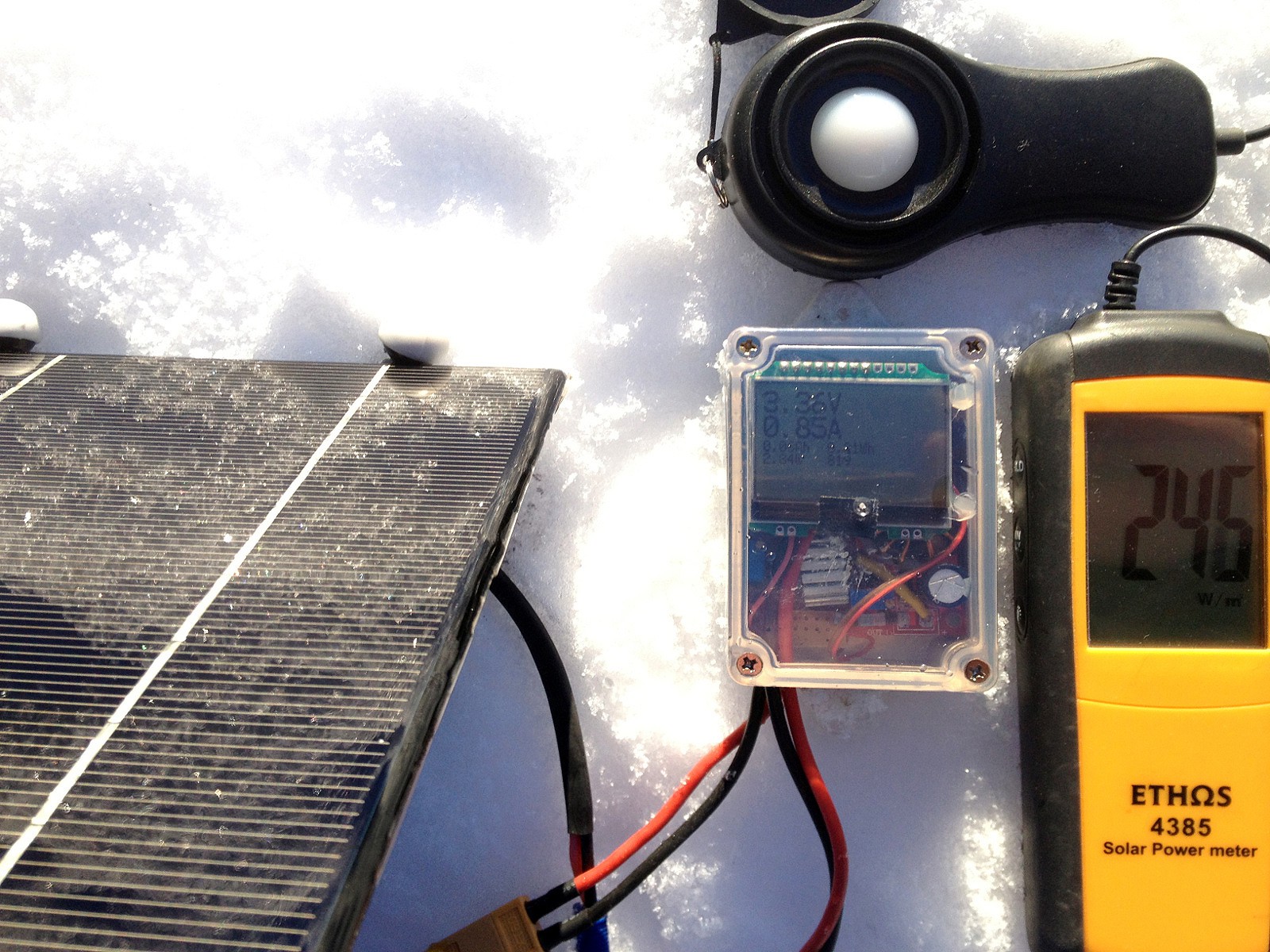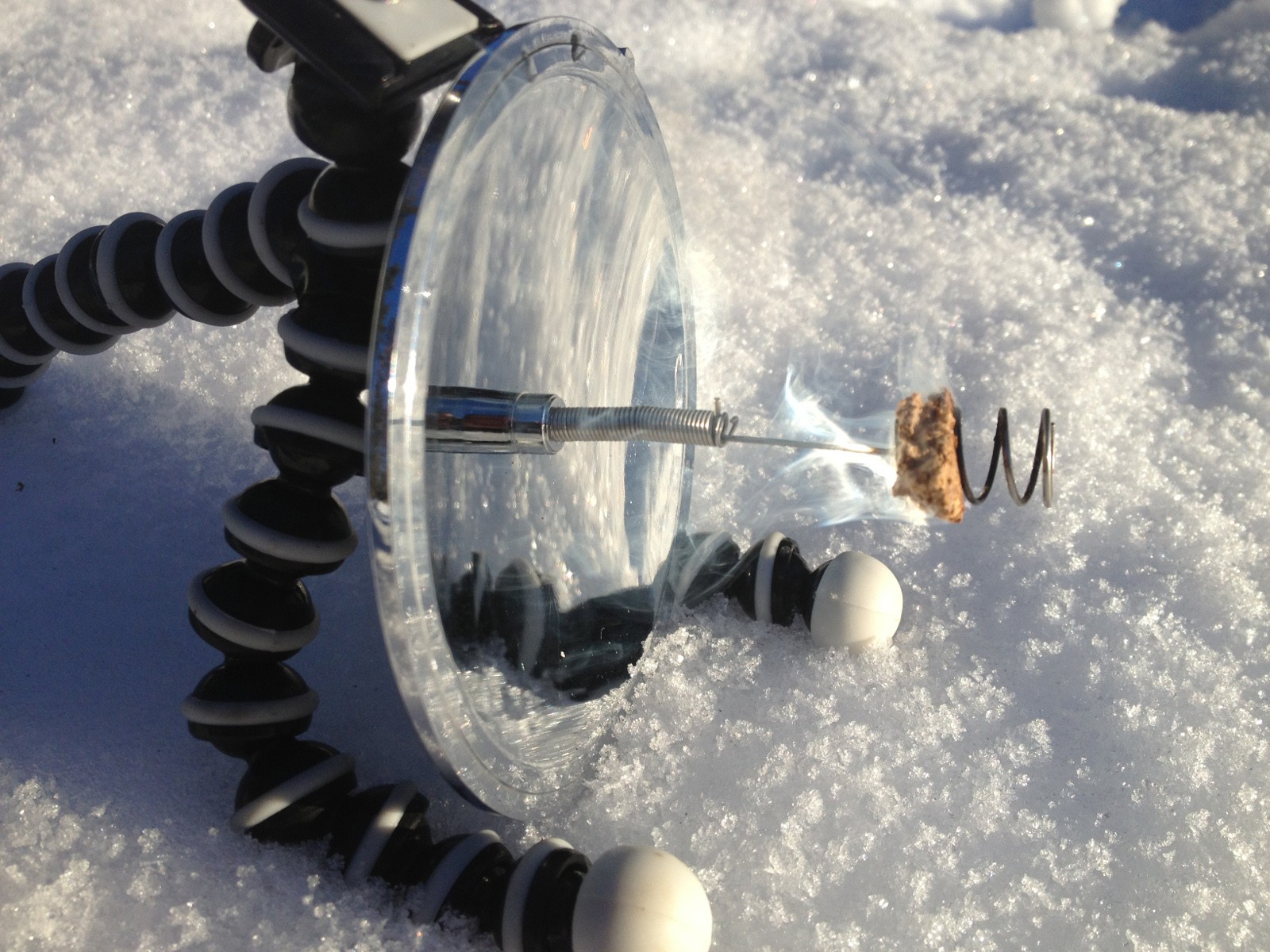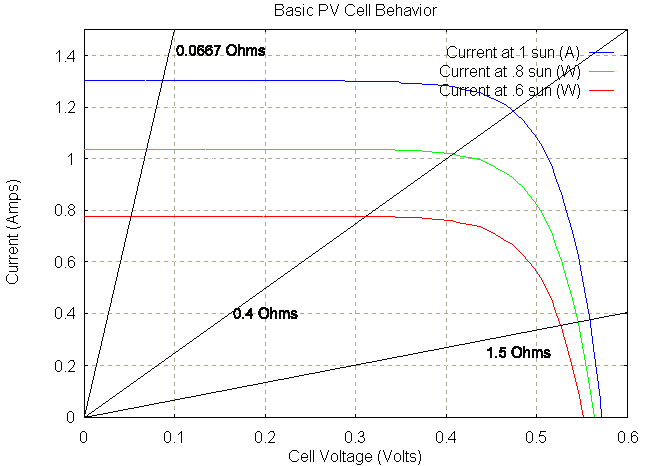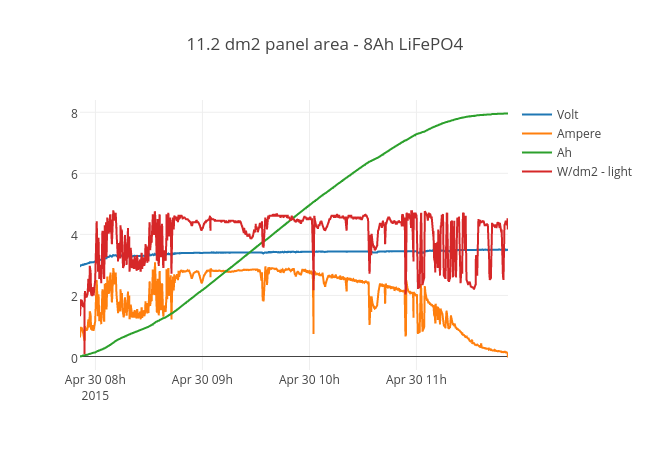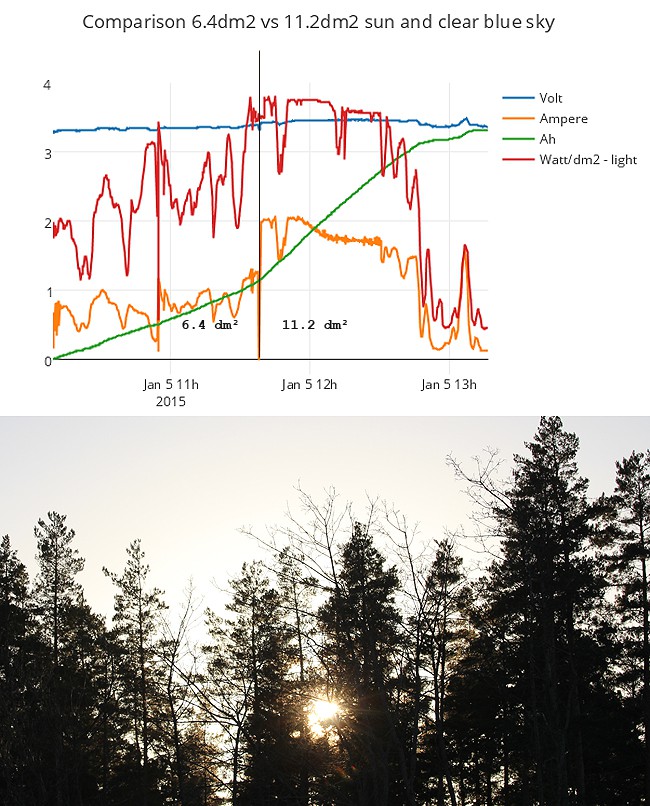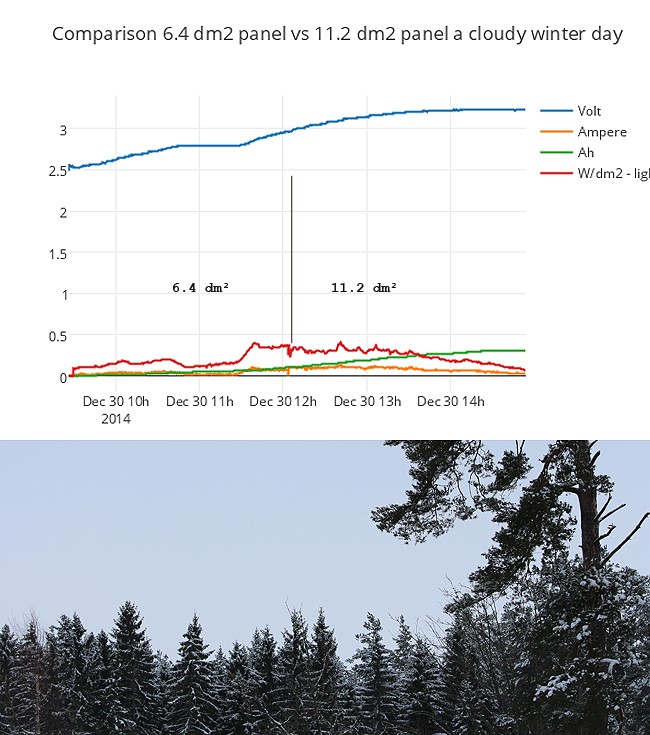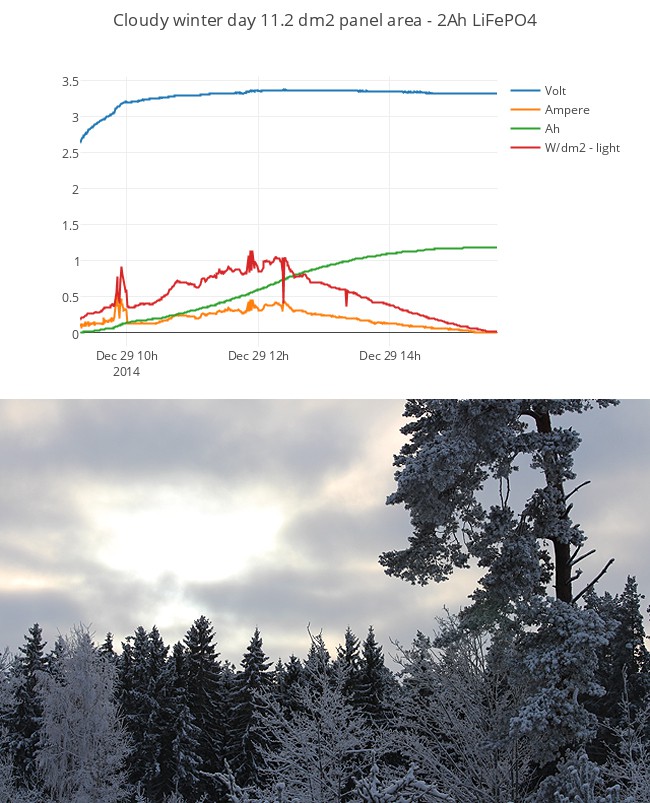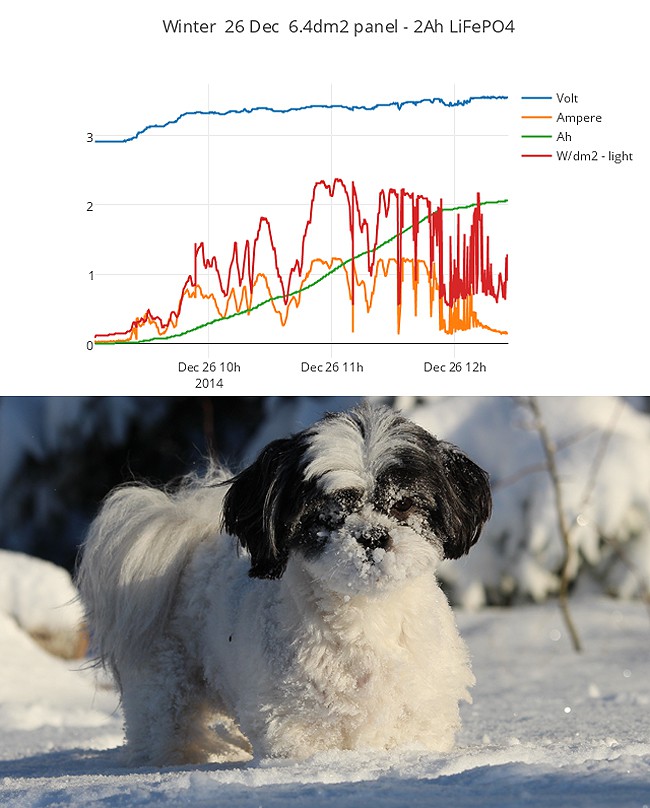-
17 Jan - 880W/m2
01/17/2016 at 18:54 • 0 comments888w/m2 - it's all about the angle ;-)
http://solarelectricityhandbook.com/solar-angle-calculator.html
0.85A - panel area 3.2 dm2
Parabolic mirror 8cm
![]()
-
RT8272 => Tiny-1charger
07/24/2015 at 08:01 • 2 commentsThe RT8272 looks very promising ( especially with a 22uF cap at Vin ), so far it has no problem charging with my smallest 0.2A to my largest 1.5 A solar panel ( with clouds or clear blue sky ).
http://tw.richtek.com/assets/product_file/RT8272/DS8272-02.pdf
Veery cheap
With a big cap at Vin I think it is regulating around under-voltage lockout ( 4.2V ) when it's cloudy
http://www.fieldlines.com/index.php/topic,144628.msg977808.html#msg977808
This might be taken one step further with the EN pin.....( if it's worth the trouble ). The under voltage lockout is close to the Mppt point for smaller "5V" panels.
But I think it's use should be limited to one panel ( <= 1.5 A )...
Putting several RT8272 in parallel is probably not a good idea since Vref "0.92v" (FB) will differ from circuit to circuit, meaning one circuit will probably get more heated than the others.
-
4 display types supported
07/22/2015 at 09:36 • 0 commentsYou can choose different display types by activating #define of your choice
( by using CE you could have multi-screen ... ;-)
#define LX12864G_086_SPI (3) //#define SSD1306_SPI (1) //#define SSD1306_IIC (2) //#define NOKIA_5110_SPI (0) // Selected display type #define DISP_TYPE LX12864G_086_SPI #define DISP_WIDTH 128 #define DISP_HEIGHT 64 #define DISP_NCOL_SMALL 21 // 128/6 small font -
Nokia 5110 replacement - JLX12864G-086-P
07/21/2015 at 11:21 • 0 comments![]() The JLX12864G-086 is in my opinion a good replacement for the Nokia 5110.
The JLX12864G-086 is in my opinion a good replacement for the Nokia 5110. Similar price 5$, better connection but slightly higher power consumption ( like 10 mA ).
The one I work with has a feature of sometimes forgetting "screen orientation", my workaround is repeating this command before writing any text. My guess it's a light sensitive part at the bottom of the display that triggers the effect. Once I've covered it with tape..problem seems to be gone.
spi_write_byte(0xa6, 0 ); /* General: Positive Display */ /* bottom 0XC8: reverse scanning order: from bottom to top*/ spi_write_byte(0xc8, 0 ); /* 0xA0: General: column address from left to right */ spi_write_byte(0xa0, 0 );http://www.electrodragon.com/product/12864min-graphic-lcd/
http://www.mikrocontroller.net/attachment/252515/JLX12864G-086.pdf
The alternative is trying to get a good connector for Nokia
http://www.starlino.com/nokia_lcd_connect.html
-
poor man's pyranometer
07/04/2015 at 06:03 • 0 commentsMost lux sensors has a limited range ( < 100 000 lux ) and I plan a different approach.
Current source current is directly proportional to the solar radiation
Measuring Solar Radiation, Chuck Wright
In a solar cell, the parameter most affected by an increase in temperature is the open-circuit voltage -2.2 mV/°C
The short-circuit current, Isc, increases slightly with temperature, since the band gap energy, EG, decreases and more photons have enough energy to create e-h pairs. However, this is a small effect and the temperature dependence of the short-circuit current from a silicon solar cell is
A change form 25 to 50 °C will increase Isc current 1.5%.
The impact of increasing temperature is shown in the figure below
Area [dm²] Isc [mA] Lux 0.000079 x lux [Watt/dm²] 0.71 ( 1W panel ) 185.5 120000 9.48 152 93500 7.39 129 76400 6.03 20.9 14300 1.13 3.1 ( 5.15w panel ) 1010 119500 9.44 850 95400 7.54 730 76500 6.04 610 58800 4.65 5.7 ( 7.5watt panel ) 1560 113200 8.94 1390 96000 7.58 1170 76200 6.02 1040 61100 4,83 http://www.pveducation.org/pvcdrom/solar-cell-operation/short-circuit-current
http://www.pveducation.org/pvcdrom/solar-cell-operation/effect-of-temperature
Pyranometers and reference cells
Pyranometers and Reference Cells, What’s the Difference ? -
April 30 - 2015 more than 100 000 lux
04/30/2015 at 10:17 • 0 commentsOften more than 100 000 lux ( resulting in unreliable lux measurements )
A 8h LiFePO4 battery is fully charged in 3.5h compared to 2.5h from an wall outlet.
-
Sun with a clear blue sky, peak 55000 lux and -1 °C
01/05/2015 at 13:09 • 0 commentsI have compared the 6.4 dm² panels with my 11.2 dm² a sunny winter day with a clear blue sky. The light intensity peaked at 55000 lux.
The theoretically available power P at 55000 lux and a 11.2 dm² panel with 0.16% efficiency is:
P = 55000*0.000079*11.2*0.16 = 7.8 Watt ( I measured close to 6.6 Watt on the battery side )
-
Very cloudy winter day, 4300 lux and 0 °C
12/30/2014 at 21:35 • 0 commentsI have compared the 6.4 dm² panels with my 11.2 dm² under harsh conditions. The light intensity peaked at 4300 lux and it was impossible to distinguish the contour of the sun. I managed to charge close to 0.5Ah. I think at least 22 dm² ( 30W panel ) is necessary to do something meaningful in this kind of light. ( When it's snowing I've measured 170 lux )
The theoretically available power P at 4300 lux and a 11.2 dm² panel with 0.16% efficiency is:
P = 4300*0.000079*11.2*0.16 = 0.6 Watt ( I measured close to 0.4 Watt on the battery side )
-
A cloudy winter day, 12000 lux and -8 °C
12/29/2014 at 15:35 • 0 commentsA cloudy winter day, but I could see the contour of the sun behind the clouds. I measured around 12000 lux peak. For this test a geared up and tested two of my "new" 7.5W panlels. You can read more about them at http://cottonpickersplace.com/ . I think these panels are very good and they come in many sizes. I prefer panels that are waterproof and has exposed soldering points. I'm evaluating if the slightly smaller panels (1.6x2dm) or this size (2.8x2 dm) is the best.
-
26 December a sunny winter day, -5 °C
12/26/2014 at 12:20 • 0 commentsWith just 6.4 dm² panel area in december (winter in Sweden) I could charge a 2Ah LiFePO4 in less than three hours. The light sensor is just a rough estimate ( It's still uncalibrated ). It is however worth to note that with a drop in temperature the efficiency of the panel increases. As an example a cell that produces 0.6A at 25 °C will produce 0.68A at 0 °C.
 mr.jb
mr.jb
